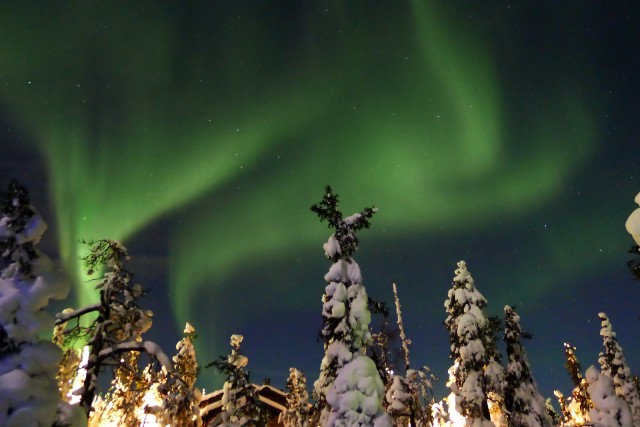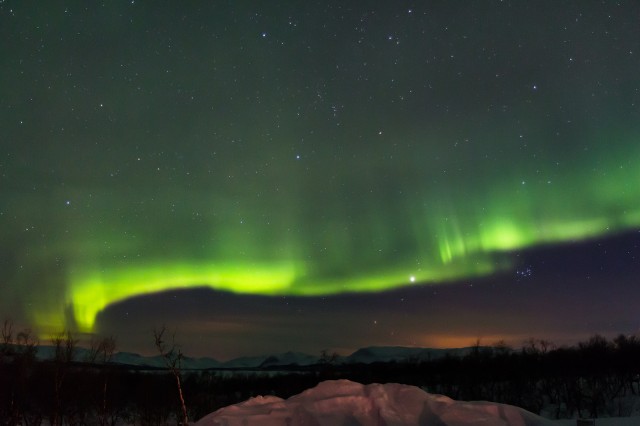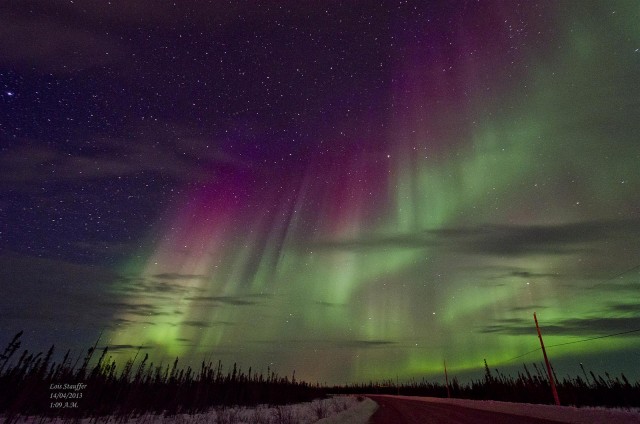The Northern Lights (Aurora Borealis) is a spectacular phenomenon that occasionally lights up the night sky in the far north. Green, blue, red, violet and many shades of these colors dance in the sky, forming shapes and pulsating almost like living creatures. Seeing the lights is pure magic that no one will forget. There is no photograph or video that can show how impressive the real thing is when the sky lights up. So, here is a guide (extracted from the travel guidebook Lapland) to finding, viewing and filming the Northern Lights by yourself.
Northern lights are frequently visible north of the Arctic Circle. It is possible, but rare, to see the lights south of the Arctic Circle as well. In the far north, the lights show up regularly, and spotting them is pretty easy if the following key factors have been covered.

2. Weather. If it is cloudy where you are, the lights give their show to someone else who is admiring it in a place where there are no clouds.
3. City lights. Even though there are not too many large towns north of the Arctic Circle, you want to move away from the brightest city lights if you want to see the full light show.
In northern parts of Lapland, long term statistics show that the Northern Lights phenomenon occurs in three out of four nights. Yet, if you want to increase your odds in seeing the Northern Lights, you need information on two things: the weather (for clear skies) and solar winds (when a strong burst is going to make contact with earth’s atmosphere).
You can find detailed weather forecasts, for instance, for Nordic countries at national meteorological web pages:
Weather forecast for Sweden: www.smhi.se/vadret
Norway: www.yr.no
Finland: en.ilmatieteenlaitos.fi
Predicting the time when the Northern Lights appear is based on the sun’s activity. The sun continuously emanates electrons and protons to the space. The flow of these electrically charged particles is known as the solar wind. The wind correlates with bursts of sunspots. When a burst causes strong enough solar winds, the particles arrive in earth’s magnetosphere in one or two days. When it happens, the particles collide with gas in earth’s atmosphere and turn on the colorful lights for the majestic show.
Northern Lights prediction service for Lapland: www.aurora-service.eu/aurora-forecast/
Predictions for other regions: spaceweather.com
Viewing the Northern Lights
Viewing the light show is simple: look at the sky. When the Northern Lights are alive, the northern sky is the silver screen for the show. The colorful lights are easily seen by the naked eye, no instruments or aids are required. In order to maximize your viewing area, position yourself so that nothing blocks your view to the northern sky.
The lights are not harmful, they are dancing at the height of 100 km / 62 miles and above from earth. Only an extremely strong solar wind may cause disturbances to sensitive magnetic and electric devices.
You don’t have to search for a particular place where seeing the Northern Lights is supposed to be guaranteed or the views are better than in another place. It doesn’t make a difference if your viewpoint is at the top of a mountain, bottom of a valley, at the yard of a rented cottage or at a car park. Especially in Lapland, ski resorts, hotels, and activity centers like to advertise how their place is the best for viewing the Northern Lights, but in reality, only the previously listed factors matter.
There are hotels, like Kakslauttanen Arctic Resort in Finnish Lapland that has cottages with glass roofs. Then, you don’t have to go out at all, but you can sit on the couch (in the dark) and wait for the light show to start.
Apps and alerts for Northern Lights
Some Nordic national meteorological institutions have public alert systems that send out email messages when the Northern Lights are expected, and a number of ski resorts, like Levi and Ylläs in Finnish Lapland have their own mobile applications that alert of lights. Alert applications that can forecast the appearance of lights in all areas are available for Android and Apple mobile devices.
For Android phones and tablets:
For Apple mobile devices:
Alerts via Twitter twitter.com/Aurora_Alerts
Web page that shows the situation in Lapland www.aurora-service.eu/aurora-forecast/
Photographing the Northern Lights
You can try photographing the rapidly changing lights with an ordinary compact camera or camera phone (choose the night mode), but if you want to capture decent images you need better gear, and you have to know how to use the gear. You need:
– A camera that can take good images in high ISO setting. The higher ISO value you can set, the better your chances are for capturing a sharp image.
– A lens with wide aperture. f2.8 or less is recommended.
– A tripod.
– Spare batteries if you intend to take more than a few pictures in cold climate. Freezing temperatures quickly suck out life from batteries.
Tips for shooting the Northern Lights:
– Set the largest aperture your lens allows.
– Choose the highest ISO value that still provides reasonable image quality.
– Set the focus at infinity. Do it manually. If you can’t, focus on the most distant object you can see.
– Set the exposure time to as short as possible. For instance, if the aperture is f2.8 and ISO value is 800, try exposure time between 4 and 15 seconds.
More information for visitors available in the travel guide to Lapland.


